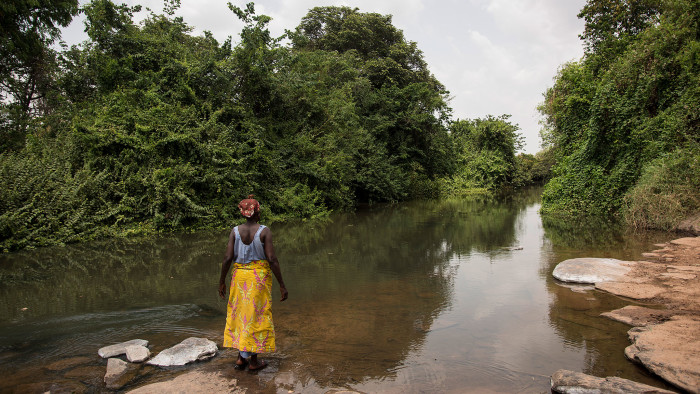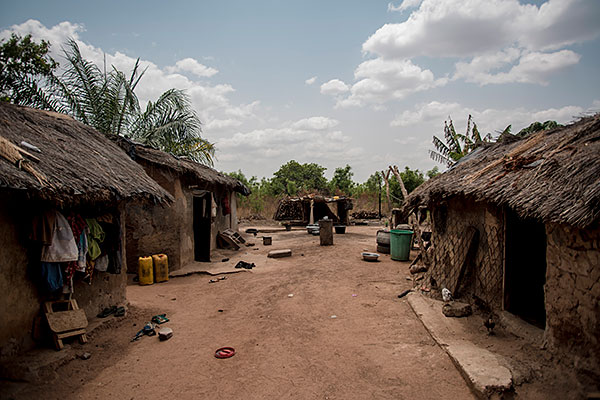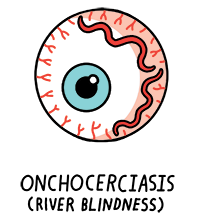‘We didn’t know we would go blind’: fighting onchocerciasis in Ghana

Roula Khalaf, Editor of the FT, selects her favourite stories in this weekly newsletter.
Francis Queye treks down a dusty path in the baking lunchtime heat between palm nut trees towards a cluster of mud-caked huts. He is carrying a wooden rod with four black lines marked along its length. In a clearing under a tree in the hamlet of Fa-asemkye, he holds it upright to measure the height of a three-year-old boy. He hands him a single pill to swallow with a gulp of water and writes his name, Daniel Bah Joshua, in his notebook.
Queye is one of the thousands of volunteers who are mobilised twice a year across Ghana to perform this procedure. It is a simple routine, but in the coming years it could rid the country of onchocerciasis, an insect-transmitted scourge that affects about 37m people worldwide, the vast majority in Africa.
Known colloquially as river blindness, the disease is caused by a parasite that spreads via the bite of the blackfly breeding on the banks of fast-flowing rivers. Left untreated, worms grow inside the body, causing itching, lumps and eventually blindness, when they enter the eye. A periodic dose of ivermectin — a drug originally developed to tackle parasites in dogs — can both treat and protect against the disease.
With no easy access to weighing scales as he travels about, Queye uses his measuring stick to estimate people’s size and assess how much medication they need, before administering between one and four tablets. A cocoa farmer, he was recruited last year to work on an ambitious national campaign to eliminate the disease (technically, elimination means reducing the number of cases to less than 0.1 per cent of the population) within the next four years. “I do this out of patriotism,” he says.
The programme, which is funded by the state and non-governmental organisations, including the UK charity Sightsavers, begins in the factories of Merck, the US pharmaceutical company that developed ivermectin and has been donating it for almost three decades. The medicine is shipped to voluntary drug distributors such as Queye, who seek to reach the millions at risk in remote areas. In the Birim North district of southern Ghana, where Fa-asemkye is located, 62,000 people were given ivermectin last year.

Substantial progress has been made since this so-called “mass drug administration” began. But that was in 1998, and the campaign is continuing, with an estimated 5m people still at risk in Ghana.
In the past few years, the number of districts reporting river blindness has dropped sharply, giving the programme’s co-ordinators the confidence to shift from a target of bringing the disease under control to planning its elimination. But the final stretch will be difficult. Ivermectin only kills the baby worms, or microfilariae, in the body, so it has to be given each year for up to 15 years — the lifetime of the adult worms that continue to live and reproduce inside the body. This requires the continued distribution of drugs and laborious surveillance of patients.
“It’s a big challenge getting access to the community,” says Thomas Azurago, the health director in Birim North’s administrative centre, New Abirem. The district has no ambulance and cars are in very short supply, with just a few motorbikes for health workers to reach remote areas. It is not always easy to find and retain unpaid community drug volunteers, whose goodwill is being stretched as a growing number of competing disease programmes seek them to dispense advice and distribute products, including drugs and anti-malaria mosquito nets.

While most people in the villages are happy to take ivermectin, some have been put off by potential side-effects on a scale from itching to, very rarely, a life-threatening skin condition called Stevens-Johnson syndrome. In Azurago’s district, just 2 per cent of people actively refused to take the drug last year, official data show, but about 6 per cent of locals simply did not turn up on the day they were scheduled to receive it, with many busy at work on their farms or away on errands.
The success of the programme has, in itself, been a brake on the final push to elimination. Onchocerciasis is no longer widely seen in communities and, as a result, it is not perceived to be a serious threat. Meanwhile, the health system is struggling to cope with other pressures; Azurago says his colleagues are more concerned about malaria, respiratory infections and a rise in cases of hypertension and other lifestyle-related diseases.

Several hours’ drive from Birim North in the fishing settlement of Asubende, which means “by the river” in the local language, half a dozen people in their 60s and 70s sit on benches and talk about how they became blind after years of untreated infection.
“We didn’t know the disease was transmitted by flies or that we would go blind,” says Emmanuel Duako, a fisherman, recalling the many members of his parents’ generation who were blind. “We thought it was just linked to old age. We didn’t know the cause. We used to go to the river to fish and to wash,” he says. Many of his friends also lost their sight.
Mary Bacheyiri, a retired teacher, is a local community drug distributor who works for a range of different health programmes. She visits schools to talk to pupils about the importance of using bed-nets as a guard against malaria-carrying mosquitoes and boiling water to prevent other infections. She says she was motivated to volunteer after her husband went blind from onchocerciasis: “He was tested and diagnosed with river blindness, but he began to itch after starting the tablets and stopped taking them,” she says. “The others who took the drugs were fine.”
The prevalence of river blindness has fallen sharply in Asubende, down from 88 per cent in 1987 to 3 per cent in 2014. But tracking down remaining cases is difficult both for onchocerciasis and another neglected condition in Ghana, lymphatic filariasis, which threatens an estimated 12m people across the country and carries great stigma. Also known as elephantiasis, it is transmitted by mosquitoes and can lead to painful and disabling swelling in the arms, legs and genitals if left untreated. Sores develop that cause further infection, and sometimes amputation is necessary. In most cases, the fluid cannot be drained from the limbs, although men can have surgery to alleviate swelling of the scrotum (hydrocele).

“People can’t work, can’t walk, have to stay at home and cannot have sex,” says Benjamin Marfo, a surgeon and the deputy programme manager of neglected tropical diseases at Ghana’s health ministry. He estimates that several thousand people are waiting for operations for hydrocele and some amputations.
Marfo has just returned from a trip to the country’s far north, and describes the difficulty of identifying lymphatic filariasis there. Even though less intrusive diagnostics are being introduced, the traditional technique requires analysis of blood taken from patients at night — the only time when the worms migrate to the surface of the body and can be identified. That requires healthcare workers to bring people together when they would normally be sleeping and to overcome suspicions of occultism that are linked to the drawing of blood. “People sometimes think you are involved in rituals,” he says.
Lymphatic filariasis can be treated with an annual dose of ivermectin combined with albendazole, a drug developed and donated worldwide by GlaxoSmithKline. The medicines cannot cure or reverse the condition but have at least prevented further deterioration for Naomi Cominey, who was diagnosed belatedly after she felt pain, swelling and liquid oozing from her legs.
“At first, people told me it was because I had sinned against my husband, and I shouldn’t go to hospital or they would amputate,” she says. Instead, alongside periodically taking the drugs, she still manages to work as a hairdresser. She has learnt to wash her legs carefully and to elevate them at night to ease the swelling.

Greater co-ordination of the distribution of the two drugs since 2007 has helped bring down the number of people at risk, from 12m in 98 districts in 2001 to 2m in 17 districts today. Public health experts say the increasing use of mosquito nets has also helped stem the spread of elephantiasis.
Other man-made interventions in Ghana have had confounding effects. On one hand, building dams in Birim North to allow gold mining to expand has slowed the flow of rivers there, reducing the size of breeding grounds for blackfly. But the larger volume of stagnant water has created an attractive new habitat for mosquitoes and the river snails that carry another neglected tropical disease, schistosomiasis (snail fever).
Cross-border migration means similar momentum is needed on public health from neighbouring countries such as Ivory Coast, says Nana-Kwadwo Biritwum, the Ghanian health ministry’s neglected tropical diseases programme manager. There is, however, good reason to hope the hurdles can be overcome. In the past few years, Ghana has rid itself of polio and Guinea worm, and plans to submit a dossier to the World Health Organization this autumn to say it is now also free of trachoma, a bacterial infection that causes blindness. This would help build confidence that it can also eliminate lymphatic filariasis by 2020 and onchocerciasis by 2025.
That may be scant comfort to an older generation who will continue to bear the burden of infection. Villages such as Asubende have been largely abandoned by younger generations fleeing the disease, says Duako. “Most people moved elsewhere. Those who are still here have no place to go.” But at least the remaining children, some of whom are running around nearby, face a healthier future than Duako and his generation.



Comments